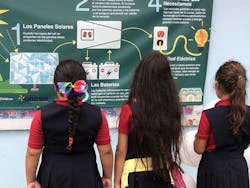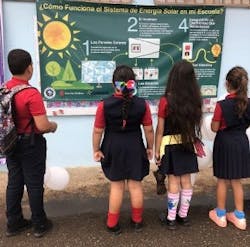Economics often decide the fate of a microgrid proposal. Sometimes, however, the calculator gets set aside when the project has a strong humanitarian purpose. Such is the case with a program launched by the Rocky Mountain Institute (RMI) and Save the Children to build school microgrids in Puerto Rico.
Photo courtesy of Rocky Mountain Institute
The program emerged after RMI began exploring ways to help the US territory recover from last year’s Hurricane Maria, a brutal onslaught that destroyed the island’s power grid, caused $90 billion in damages and led to an estimated 2,975 deaths.
RMI learned via Save the Children that the storm kept children out of school 13 million cumulative days. With severe damage to buildings and no electricity in many locations, the public education system shut down for two months. Some schools reopened only half time, others never at all.
“Because they didn’t have electricity to power their refrigerators, or get water to students, schools had to remain closed,” said Ana Sophia Mifsud, an associate with RMI’s Islands Energy Program.
The absence of electricity caused a range of operational problems. Lack of Internet delayed communications to principals from Puerto Rico’s Department of Education. Lack of light left kitchen workers fumbling in the dark.
“A lot of kitchen staff come before the sun rises, and it’s dangerous for them to be cooking and cutting things in the dark,” Mifsud said.
But it turned out the hurricane wasn’t the only problem. An unreliable grid and the remote location of some of Puerto Rico’s communities made electricity an uncertain commodity even before Hurricane Maria.
So RMI and Save the Children launched a pilot project to install renewable microgrids in 12 schools that serve Kindergarten through Grade 8, most with 200-500 students.
The partners selected the schools not because they offered the best test case for a microgrid, but because they had the greatest need.
“Most of these schools are in communities that are incredibly poor, where most people would not think to put in a microgrid,” Mifsud said.
We are now accepting nominations for the Microgrids for the Greater Good awards program. Winners will be announced at Microgrid 2019 in San Diego, May 14-16.
RMI and Save the Children started up their first school microgrid last month in Orocovis, a mountain town of about 23,000 people 50 miles from San Juan. The microgrid, which includes a 15-kW rooftop solar array and a 34-kWh lithium-ion battery system, is electrifying an elementary school with 234 students.
The microgrid cost $100,000-120,000, a figure that included extensive rewiring within the school. The money came from an array of donations.
The team hopes to have a second school microgrid up and running in January.
But it’s a school-by-school endeavor dependent on raising funds for each project. And the 12 chosen schools are just a drop in the bucket — Puerto Rico has roughly 1,400 public schools.
So RMI is looking for ways to scale more quickly, possibly by partnering with other nonprofits. The Red Cross, for example, has pledged to help 100 schools. RMI also is carefully watching action by the education department following enactment of a resolution in August that requires the department create a pilot program advancing renewable energy in schools.
The RMI/Save the Children microgrids all use renewable energy, a decision made to help move Puerto Rico away from thinking of back-up generation as “a diesel generator rusting in your backyard, which-is-business as usual with people in disaster areas,” Mifsud said.
The partners also are pursuing the ‘energy efficiency first’ principle — looking for ways to save energy in the building before installing the school microgrids. This allows the schools to install smaller — and therefore less costly — microgrids. RMI found that every percent in energy savings achieved, reduces microgrid costs by about the same.
Solar panels on Orocovia school. Photo courtesy of Rocky Mountain Institute
Mifsud said it’s important to note that the school microgrids are more than “sexy generators.” They also can help support Puerto Rico’s grid by providing it with power when the solar and energy storage systems are not used by the schools on weekends, holidays and in summer. In addition, the central grid operator can access microgrid batteries for load shifting and frequency regulation. In return, the education department gains a new revenue stream.
RMI envisions the school microgrids achieving several tasks, not only electrifying the schools and bolstering the grid, but also serving the larger community; for example, offering community access to the Internet.
The value steams are many, she said, adding that some aren’t quantifiable — like the value of creating stability in a child’s life.
In addition to Orocovis, the towns chosen for the school microgrids are: Ciales, Morovis, Corozal, Naranjito, Comerío, Barranquitas, Aguas Buenas, Canóvanas, Yabucoa, Humacao and Las Piedras.
Track news about the development of school microgrids in Puerto Rico. Subscribe to the free Microgrid Knowledge newsletter.








